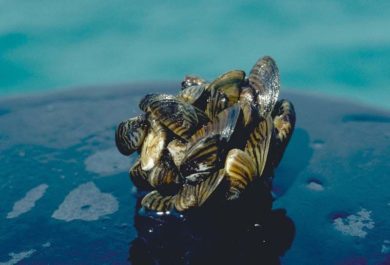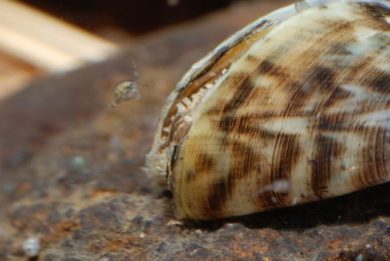 An exotic, invasive species, Zebra Mussels were first detected in North America in the mid-1980s and spread rapidly. They were accidentally brought to North America, probably in ship ballast water. They now are found in the Great Lakes basin, most of the Mississippi River drainage, the Hudson River, and many other eastern North American rivers. Examination of mitochondrial DNA indicate that populations in both North America and Europe originated from the Ponto-Caspian Sea region. An important ecological impact of invading Zebra Mussels in North America has been the decline and local extinction of native mussel species.
An exotic, invasive species, Zebra Mussels were first detected in North America in the mid-1980s and spread rapidly. They were accidentally brought to North America, probably in ship ballast water. They now are found in the Great Lakes basin, most of the Mississippi River drainage, the Hudson River, and many other eastern North American rivers. Examination of mitochondrial DNA indicate that populations in both North America and Europe originated from the Ponto-Caspian Sea region. An important ecological impact of invading Zebra Mussels in North America has been the decline and local extinction of native mussel species.
Key Characteristics
- Size: 5 cm maximum length
- Shape: The ventral side of the mussel is flattened, so much so that the mussel shell will stand on a flat surface.
- Periostracum: Usually brown with stripes that give the species its common name, but patterns and the darkness of color varies.
- Similar Species: None
Conservation Status
Highly invasive species. An important ecological impact of invading Zebra Mussels in North America has been the decline and local extinction of native mussel species. In Vermont, they have decimated native mussel populations in Lake Champlain.
Habitat
It has been found at depths of greater than 60 m. It is most abundant on hard surfaces in calm waters in lakes and upstream of dams.
 Host Species
Host Species
None. Zebra mussels have a free-swimming larval stage called a veliger. These are small enough (~0.1 mm) too easily drift in the water. The veligers have a tiny shell, and a curved sheet of skin called a velum, that is covered with tiny hairs that beat in the water to help them swim and draw food particles to eat.
Range
Zebra mussels are native to the drainage basins of the Black, Caspian and Aral seas in eastern Europe. It is believed that ships originating from European ports carried the mussel in freshwater ballast that was discharged into Great Lake ports. The first North American Zebra Mussels were discovered in Lake St. Clair, MI in 1988. By September 1991, they were found throughout the Great Lakes, St. Lawrence River, the NY Finger Lakes region, and much of the Mississippi River basin. It will likely continue to spread throughout North America.
In Vermont, it was first reported from southern Lake Champlain at Benson Landing in 1993. In 1994, they were found to be widespread in southern part of the lake, in clusters north to Burlington, and individually to Rouses Point. The Vermont Department of Environmental Conservation, in cooperation with the Lake Champlain Basin Program, initiated the Lake Champlain Zebra Mussel Monitoring Program in 1994 to track the zebra mussel’s distribution through the lake. Zebra mussel adults have been well established in the south, central, and northwest regions of the lake since 1996.The range expansion in the northeast region of the lake is now complete. In 2016 Zebra mussels continued to reproduce and settle successfully in Lake Champlain.
No veligers were found in samples taken in 2010 from the Lamoille River, Missisquoi River, and the Winooski River. The Connecticut River in North Thetford was sampled in 2014 and no veligers were detected.
In other lakes surveyed by the Lake Champlain Zebra Mussel Monitoring Program, Zebra Mussels been found in Lake Bomoseen since 1999. Veligers were found in Lake Carmi in 2010. This has happened before at Lake Dunmore and Lake Hortonia, and no infestation had taken place. In 2011, 10 samples were taken at Lake Carmi, and no veligers were found. Four samples from Lake Carmi were collected and analyzed in 2012 with no veligers found. Twenty-six lakes deemed high risk for zebra mussel infestation were sampled in 2016 with no veligers detected.
In Vermont rivers, adult Zebra Mussels were found in the LaPlatte River in 1997, and in Lewis Creek and Otter Creek in 1998. Veligers had been found in Little Otter Creek and the Winooski River in 1999. In 2002, researchers found two adult Zebra Mussels in samples from dismantled Sea Lamprey nests in Lewis Creek, upstream of the Route 7 bridge.






